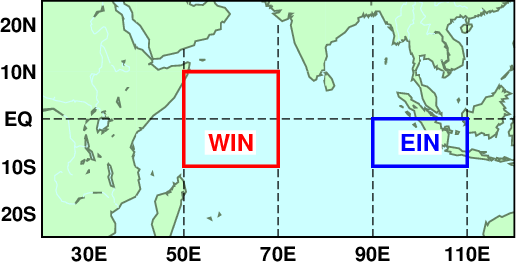 |
 |  |
|
|||
Home |
World Climate |
Climate System Monitoring |
El Niño Monitoring |
NWP Model Prediction |
Global Warming |
Climate in Japan |
Training Module |
Press release |
Links |
Figure 1. Typical anomalies of SST and lower-tropospheric circulation associated with pure positive IOD events in the mature stage. H and L denote anti-cyclonic and cyclonic circulation anomalies, respectively. |
Table 1. Historical IOD events observed since 1949
|
| Positive IOD | Negative IOD |
|---|---|
| summer 1958 - autumn 1958 | |
| summer 1961 - autumn 1961 | |
| summer 1963 - autumn 1963 | |
| summer 1967 - autumn 1967 | |
| summer 1972 - autumn 1972 | autumn 1975 |
| summer 1982 - autumn 1982 | summer 1984 - autumn 1984 |
| summer 1985 | |
| summer 1992 - autumn 1992 | |
| summer 1994 - autumn 1994 | summer 1995 - autumn 1995 (concurrent La Niña event in autumn) |
| summer 1996 - autumn 1996 | |
| summer 1997 - autumn 1997 | summer 1998 - autumn 1998 (concurrent La Niña event in autumn) |
| summer 2005 - autumn 2005 | |
| autumn 2006 | |
| summer 2007 - autumn 2007 | |
| summer 2010 - autumn 2010 | |
| summer 2012 - autumn 2012 | |
| summer 2015 - autumn 2015 | summer 2016 - autumn 2016 |
| summer 2017 - autumn 2017 | |
| summer 2018 - autumn 2018 (concurrent El Niño event in autumn) | |
| summer 2019 - autumn 2019 | summer 2020 - autumn 2020 |
| summer 2021 - autumn 2021 (concurrent La Niña event in autumn) | |
| summer 2022 - autumn 2022 | |
| summer 2023 - autumn 2023 |

Figure 3. Dipole Mode Index (DMI) time series representation
|